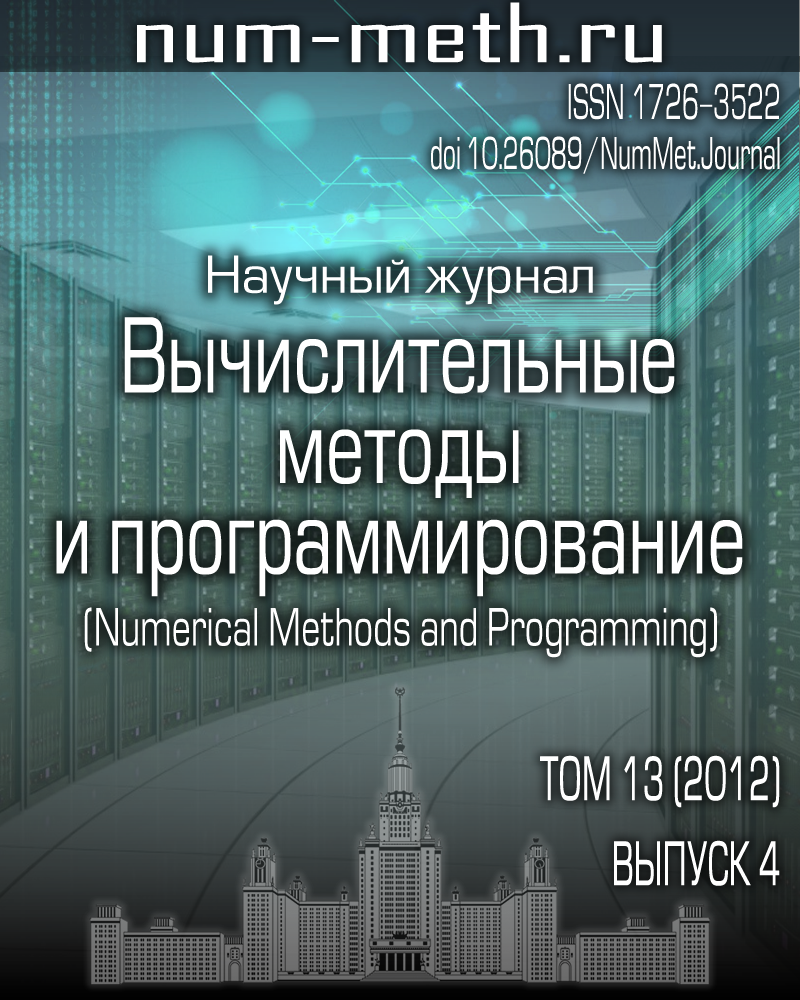Реализация метода рядов Тейлора для решения обыкновенных дифференциальных уравнений
Ключевые слова:
Аннотация
Предлагаются новые алгоритм и программа явного метода рядов Тейлора с переменной величиной шага и порядка, ориентированные на решение нежестких обыкновенных дифференциальных уравнений (ОДУ) с полиномиальными правыми частями. Используемая версия метода основана на новых простых рекуррентных формулах вычисления коэффициентов рядов Тейлора и новых строгих априорных оценках локальной ошибки в сочетании с обычными нестрогими апостериорными соображениями. Программа авторов, написанная на Фортране 95, сравнивается с тремя известными программами, которые реализуют соответственно явные методы Дормана-Принса, Грегга-Булирша-Штера и рядов Тейлора. Численные эксперименты показали конкурентоспособность предлагаемой программы, ее применимость и надежность в реальных задачах динамики.
Опубликован
Выпуск
Раздел
Библиографические ссылки
- Бабаджанянц Л.К. Метод рядов Тейлора // Вестн. Санкт-Петербургского ун-та. Сер. 10. 2010. № 3. 13-29.
- Бабаджанянц Л.К. Метод дополнительных переменных // Вестн. Санкт-Петербургского ун-та. Сер. 10. 2010. № 1. 3-11.
- Бабаджанянц Л.К., Брэгман К.М. Алгоритм метода дополнительных переменных // Вестн. Санкт-Петербургского ун-та. Сер. 10. 2012.
- Rall L.B. Automatic differentiation: techniques and applications // Lecture Notes in Computer Science. Vol. 120. Berlin: Springer-Verlag, 1981.
- Corliss G.F., Chang Y.F. Solving ordinary differential equations using Taylor series // ACM Trans. on Math. Software. 1982. 8. 114-144.
- Berz M., Bischof C., Corliss G.F., Griewank A. Computational differentiation: techniques, applications, and tools. Philadelphia: SIAM, 1996.
- Lara M., Elipe A., Palacios M. Automatic programming of recurrent power series // Math. Comput. Simul. 1999. 49. 351-362.
- Griewank A. Evaluating derivatives. Philadelphia: SIAM, 2000.
- Abad A., Barrio R., Blesa F., Rodriguez M. Breaking the limits: the Taylor series method // Appl. Math. and Computation. 2011. 217, N 20. 7940-7954.
- Rodriguez M., Barrio R. Reducing rounding errors and achieving Brouwer’s law with Taylor series method // Appl. Numer. Math. 2012. 62, N 8. 1014-1024.
- Parker G.E., Sochacki J.S. Implementing the Picard iteration // Neural, Parallel and Scientific Computation. 1996. 4. 97-112.
- Parker G.E., Sochacki J.S. A Picard-McLaurin theorem for initial value PDE’s // Abstract and Appl. Analysis. 2000. 5. 47-63.
- Pruett C.D., Rudmin J.W., Lacy J.M. An adaptive N-body algorithm of optimal order // J. of Comput. Physics. 2003. 187. 298-317.
- Carothers D.C., Parker G.E., Sochacki J.S., Warne P.G. Some properties of solutions to polynomial systems of differential equations // Electron. J. Diff. Eqns. 2005. N 40. 1-17.
- Miletics E., Molnárka G. Taylor series method with numerical derivatives for initial value problems // J. Comput. Methods in Sciences and Engineering. 2004. 4, N 1-2. 105-114.
- Molnárka G., Miletics E. Implicit extension of Taylor series method with numerical derivatives for initial value problems // Computers &; Mathematics with Applications. 2005. 50, N 7. 1167-1177.
- Nedialkov N.S., Jackson K.R., Corliss G.F. Validated solutions of initial value problems for ordinary differential equations // Appl. Math. Comput. 1999. 105. 21-68.
- Hoefkens J., Berz M., Makino K. Computing validated solutions of implicit differential Equations // Adv. Comput. Math. 2003. 19. 231-253.
- Chang Y.F., Corliss G. ATOMFT: solving ODEs and DAEs using Taylor series // Comput. Math. Appl. 1994. 28, N 10-12. 209-233.
- Berz M. Cosy infinity version 8 reference manual. Technical Report MSUCL-1088. National Superconducting Cyclotron Lab., Michigan State University, East Lansing. Mich., 2003.
- Makino K., Berz M. Taylor models and other validated functional inclusion methods // Int. J. Pure Appl. Math. 2003. 6, N 3. 239-316.
- Jorba A., Zou M. A software package for the numerical integration of ODEs by means of high-order Taylor methods // Exp. Math. 2005. 14, N 1. 99-117.
- Nedialkov N.S., Pryce J.D. Solving differential-algebraic equations by Taylor series. I. Computing Taylor coefficients // BIT. 2005. 45, N 3. 561-591.
- Nedialkov N.S., Pryce J.D. Solving differential-algebraic equations by Taylor series. II. Computing the system Jacobian // BIT. 2007. 47, N 1. 121-135.
- Nedialkov N.S., Pryce J.D. Solving differential algebraic equations by Taylor series. III. The DAETS code // J. Numer. Anal. Ind. Appl. Math. 2008. 3, N 1-2. 61-80.
- TIDES webpage URL: gme.unizar.es/software/tides.
- Hairer E. webpage URL: www.unige.ch/ extasciitilde hairer/.
- Hairer E., Wanner G., Norsett S.P. Solving ordinary differential equations: nonstiff problems. Berlin: Springer, 2009.
- Babadzanjanz L.K. webpage URL: www.apmath.spbu.ru/ru/staff/babadzhanyants/.
- Арушанян О.Б., Залеткин С.Ф. Численное решение обыкновенных дифференциальных уравнений на Фортране. М.: Изд-во Моск. ун-та, 1990.
- Wolfram Mathematica webpage URL: www.reference.wolfram.com/mathematica/guide/Mathematica.html.
- Babadzhanjanz L.K., Sarkissian D.R. Taylor series method for dynamic systems with control: convergence and error estimates // J. Math. Sci. 2006. 139, N 6. 7025-7046.
- Абалакин В.К., Аксенов Е.П., Гребеников Е.А., Демин В.Г., Рябов Ю.А. Справочное руководство по небесной механике и астродинамике. М.: Наука, 1976.
- Oesterwinter C., Cohen C.J. New orbital elements for Moon and planets // Celestial Mech. 1972. 5, N 3. 317-395.
- NASA Jet Propulsion Laboratory URL: ssd.jpl.nasa.gov/?constants.


